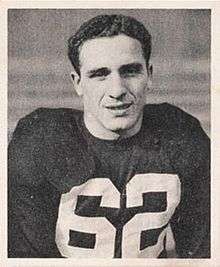Charley Trippi
 Trippi c. 1948 | |||||||||||||||
| No. 62, 2 | |||||||||||||||
|---|---|---|---|---|---|---|---|---|---|---|---|---|---|---|---|
| Position: | Halfback, quarterback | ||||||||||||||
| Personal information | |||||||||||||||
| Date of birth: | December 14, 1921 | ||||||||||||||
| Place of birth: | Pittston, Pennsylvania | ||||||||||||||
| Height: | 6 ft 0 in (1.83 m) | ||||||||||||||
| Weight: | 186 lb (84 kg) | ||||||||||||||
| Career information | |||||||||||||||
| High school: | Pittston Area High School | ||||||||||||||
| College: | Georgia | ||||||||||||||
| NFL Draft: | 1945 / Round: 1 / Pick: 1 | ||||||||||||||
| Career history | |||||||||||||||
| Career highlights and awards | |||||||||||||||
| |||||||||||||||
| Career NFL statistics as of 1955 | |||||||||||||||
| |||||||||||||||
| Player stats at PFR | |||||||||||||||
Charles Louis Trippi (born December 14, 1921) is a former American football player. He played college football at the University of Georgia and professionally in the National Football league (NFL) with the Chicago Cardinals. He was inducted into the College Football Hall of Fame in 1959 and the Pro Football Hall of Fame in 1968.
College years
Trippi attended the University of Georgia and was a unanimous All-America selection in 1946. He played for Georgia in 1942 alongside Heisman winner Frank Sinkwich. Georgia finished the season with a record of 11–1 and was named consensus national champions. He was named Most Valuable Player in the 1943 Rose Bowl in Georgia's 9–0 victory over UCLA. After his college career was interrupted by World War II, he completed his career at Georgia by playing in 1945 and 1946. He won the Maxwell Award in the 1946 season. At Georgia, he was initiated into the Lambda Chi Alpha Fraternity. Trippi graduated from the University of Georgia in 1951 with a Bachelor of Science in education.
Atlanta Crackers
In 1947, Trippi played one season of minor league baseball with the Southern Association's Atlanta Crackers before joining the NFL. He hit .334 in 106 games.[1]
NFL career
Trippi was a big part in the battling between the National Football League (NFL) and All-America Football Conference (AAFC). The AAFC's New York Yankees (AAFC) were sure they had signed Trippi, but Charles W. Bidwill Sr. of the Cardinals signed Trippi to a four–year contract worth $100,000 along with a first year bonus of $25,000.
Trippi's addition completed Bidwill’s quest for a "Dream Backfield." Although Bidwill did not live to see it, Trippi became the game breaker in a talented corps that included Paul Christman, Pat Harder, Marshall Goldberg and, later, Elmer Angsman.
Trippi participated in the 1947 NFL Championship Game when the Cardinals defeated the Philadelphia Eagles, 28-21. Playing on an icy field in Chicago, Trippi wore basketball shoes for better traction and totaled 206 yards, including 102 yards on two punt returns. He scored touchdowns on a 44-yard run and a 75-yard punt return.
Trippi played as a left halfback for four seasons before switching to quarterback for two seasons. He then moved back to offensive halfback for one season before switching over to play defense in 1954 and 1955. He was also the Cardinals' punter and he excelled on special teams. His career all but ended in the 1955 preseason when he was tackled by John Henry Johnson of the San Francisco 49ers, which left Trippi with a smashed nose, a concussion, and a protruding bone behind his eye that gave him double vision.[2] He appeared in only five games that season and did not record any statistics on offense.[3]
Trippi is the only player in the Pro Football Hall of Fame with 1000 yards of receiving, 1000 yards passing, and 1000 yards rushing. Two other players that are not in the Hall of Fame, George Taliaferro and Robert Hoernschemeyer, have that distinction as well.
After he ended his playing career, Trippi served as an assistant coach with the Cardinals from 1957 to 1965, mostly coaching the offensive backfield.
Honors
Trippi was inducted into the College Football Hall of Fame in 1959, the Georgia Sports Hall of Fame in 1965, and the Pro Football Hall of Fame in 1968. In 2007 he was ranked #20 on ESPN's Top 25 Players In College Football History list. The football stadium at Pittston Area High School in Pittston, Pennsylvania is named "Charley Trippi Stadium" in his honor.
References
- ↑ Charley Trippi Baseball stats
- ↑ "Trippi Badly Hurt; Fear Career Over". St. Petersburg Times. Associated Press. September 16, 1955. p. 12. Retrieved September 28, 2016.
- ↑ "Charley Trippi Stats". Pro-Football-Reference.com. Sports Reference LLC. Retrieved September 28, 2016.
External links
- Official website
- Charley Trippi at the Pro Football Hall of Fame
- Charley Trippi at the College Football Hall of Fame